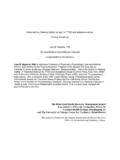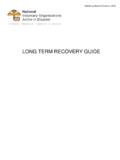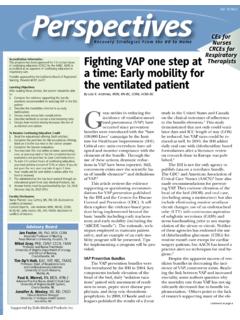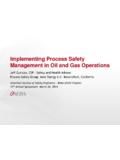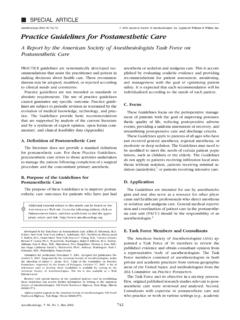Transcription of Implementing a Ship Energy Efficiency …
1 Implementing a ship Energy Efficiency management plan ( seemp ) Guidance for shipowners and operators Lloyd s Register, its affiliates and subsidiaries and their respective officers, employees or agents are, individually and collectively, referred to in this clause as the Lloyd s Register Group . The Lloyd s Register Group assumes no responsibility and shall not be liable to any person for any loss, damage or expense caused by reliance on the information or advice in this document or howsoever provided, unless that person has signed a contract with the relevant Lloyd s Register Group entity for the provision of this information or advice and in that case any responsibility or liability is exclusively on the terms and conditions set out in that contract.
2 Implementing a ship Energy Efficiency management plan ( seemp ) Guidance for shipowners and operators June 2012 (version ) i Contents 1. Introduction 1 2. seemp purpose 1 3. IMO background 1 4. Current state of IMO regulation and seemp 2 5. seemp main features 2 Planning 3 Implementation 3 Monitoring 3 Self-evaluation and improvement 3 6. Methods for Energy improvement 4 Appendix 1 Useful references 5 Appendix 2 Frequently asked questions 5 Appendix 3 Glossary 7 Implementing a ship Energy Efficiency management plan ( seemp ) Guidance for shipowners and operators June 2012 (version ) 1 1. Introduction These guidance notes provide advice to shipowners and operators who wish to implement a ship Energy Efficiency management plan ( seemp ) early on a voluntary basis, or prepare themselves for its mandatory implementation from January 1st, 2013.
3 The guidance reflects the current status of the IMO regulations and provides information on the structure of a seemp as well as optional seemp services offered by Lloyd s Register. 2. seemp purpose The seemp is a management tool to assist shipowners in managing the Energy Efficiency of their ships. It is applicable on a voluntary basis at present and is designed to provide the framework, against which, a shipowner can develop best practice and Energy efficient operations. The IMO will introduce the seemp as a mandatory tool under MARPOL Annex VI, entering into force on January 1, 2013. 3. IMO background The International Maritime Organisation (IMO), as the main regulatory body for shipping, has, in recent years, devoted significant time and effort in order to regulate shipping Energy Efficiency and thereby control the marine GHG emissions.
4 For this purpose, IMO has developed a number of technical and operational measures that include: Energy Efficiency Design Index (EEDI); Energy Efficiency Operational Index (EEOI); ship Energy Efficiency management plan ( seemp ). The IMO has also been working on a number of Market-Based Measures (MBMs) for the marine industry. The MBMs development is still ongoing. The EEDI represents one of the major technical regulations for marine CO2 reduction and the IMO, under the banner of the Marine Environmental Protection Committee (MEPC) and its associated Energy Efficiency working group, has been finalising the regulations and guidelines for the EEDI with input from each of the various flag states and other industry bodies.
5 Figure 1shows the MEPC s activity timeline. Resolution (23) IMO policies and practices related to reduction of GHG emissions from ships MEPC Energy Efficiency Operational Indicator Dec 2003 Jun 2005 Mar 2008 Jun 2008 GHG Working Group 1 Oct 2008 Feb 2009 Jul 2009 Mar 2010 Jun 2010 Sep 1997 Reg text Jul 2011 EEDI & seemp Adopted Sep 2010 Resolution 8 CO2 emissions from ships GHG Working Group 2 MEPC Circ. 681 EEDI Calculation MEPC Circ. 682 EEDI Verification MEPC Circ. 683 seemp MEPC Circ. 684 EEOI Energy Efficiency Working Group MEPC 40 MEPC 53 MEPC 57 MEPC 58 MEPC 59 MEPC 60 MEPC 61 MEPC 62 Mar 2012 Guidelines Adopted: (63) EEDI Calculation (63) seemp (63) EEDI Verification (63) EEDI Ref Lines MEPC 63 Figure 1: MEPC and Working Group Timeline Implementing a ship Energy Efficiency management plan ( seemp ) Guidance for shipowners and operators Lloyd s Register 2 4.
6 Current state of IMO regulation and seemp At MEPC 62 in July 2011, the mandatory implementation of the EEDI and seemp was agreed. The seemp will form part of MARPOL Annex VI and the requirement will be applicable to all ships, both new and existing, of 400 gross tonnage and above, whereby each ship will be required to keep a seemp onboard. The proposed amendments to MARPOL Annex VI will enter into force on January 1, 2013 and they include a new chapter, Chapter 4, Regulations on Energy Efficiency of ships . The seemp shall be developed taking into account guidelines adopted by IMO (currently these guidelines are Resolution (63) 2012 Guidelines for the Development of a ship Energy Efficiency management plan ( seemp ) and they replace previous guidelines, ).
7 Compliance with the proposed MARPOL Annex VI Regulation 22 ( seemp ) will be demonstrated in the International Energy Efficiency (IEE) Certificate, which also forms part of the proposed MARPOL amendments, and will be subject to the usual MAPROL surveys (initial, renewal, intermediate, annual etc.). 5. seemp main features Shipping is a relatively efficient mode of transport compared to land and air when you consider the CO2 emissions produced per mile that each tonne of cargo is transported. However, shipping is also coming under increased scrutiny to lower its GHG by the international community and, under its remit, the IMO is looking at promoting measures to control these by improving ship Efficiency through better management and implementation of best practice.
8 The seemp provides a means to formally capture processes by which a shipowner can seek to improve the environmental Efficiency aspects of their operations both onboard each of their ships as well as company-wide. The seemp is a live document, containing Energy improvement measures identified by the ship owner, that will be kept onboard each ship . The document will be reviewed regularly to establish the relevance and impact of each measure on ship and fleet operations. Each seemp will be ship specific but should be linked to a broader corporate Energy management policy of the shipowner. In some cases, the seemp may form part of the ship s Safety management System (SMS) and many shipowners will already have an Environmental management System (EMS) under ISO 14001 which contains relevant practices for environmental improvement that may augment the seemp .
9 There are four key processes that the seemp must address and describe and together they form a continuous improvement process as shown in Figure 2. Each process, taken from the seemp Guidelines ( (63), has been summarised in the following sections. Figure 2: seemp processes Planning Implementation Self-Evaluation and Improvement Monitoring Implementing a ship Energy Efficiency management plan ( seemp ) Guidance for shipowners and operators June 2012 (version ) 3 Planning As part of each seemp , the ship owner is required to review current practices and Energy usage onboard each ship with a view to determining any shortfalls or areas for improvement of Energy Efficiency . This is a crucial first step to developing an effective management plan and should identify various aspects relating to: ship -specific measures For example: speed optimisation, weather routeing, hull maintenance, machinery operation.)
10 Company-specific measures For example: improved communication and interaction with other stakeholders, such as charterers in order to assess feasibility of just in time operation or traffic management services for availability of berth etc. Human resource development Awareness and training of personnel is critical in ensuring successful implementation of any measures. Goal setting This aspect is voluntary but serves as a means for a shipowner to provide incentive for Energy reduction both at ship level but also at corporate level. This is not subject to external inspection. Implementation Upon completion of the planning stage, a system of how each Energy improvement measure is to be implemented needs to be developed.
